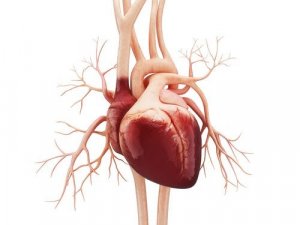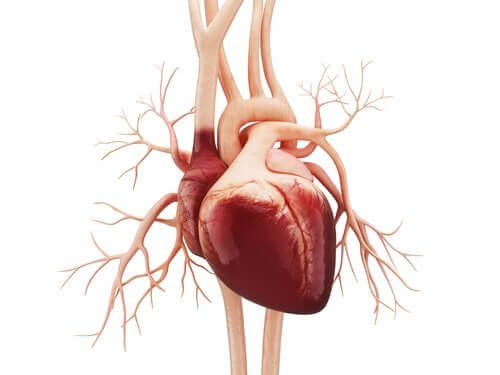Atrial Flutter: Symptoms and Causes

Atrial flutter is an arrhythmia, a heart rhythm disorder. It consists of the production of abnormal and quick electrical discharges in the atrium. These discharges cause a faster contraction of the atria. Therefore, only some of these electrical impulses reach the ventricles. This makes them contract irregularly, faster, and less efficiently than normal.
Atrial flutter is similar to atrial fibrillation. However, the rhythm is more organized during the flutter than when fibrillated. It’s a relatively frequent disorder. In fact, its highest incidence is in middle-aged men (60 years old).
In today’s article, we’ll explain what atrial flutter is together with its symptoms and causes.
How does atrial flutter occur?
Under normal conditions, the heart cavities (atria and ventricles) rhythmically and synchronously contract by an electrical impulse. This impulse originates in the atrium and then goes to the ventricle – a heartbeat. Its normal frequency is between 50 and 100 beats per minute. However, the mechanism alters during an arrhythmia. The heart stops contracting regularly. If the rhythm is greater than 100 beats per minute, then we refer to it as tachyarrhythmia.
The activity of the atria remains coordinated when it comes to atrial flutter. The problem is the atria contract at a rate of more than 250 times per minute. Therefore, the impulses cannot properly reach the ventricles. In fact, the ventricles only reach about one in two impulses. This causes a heart rate of about 150 beats per minute. In medical terms, atrial flutter is a tachyarrhythmia produced by a macro-reentry circuit.
What causes atrial flutter?
Atrial flutter is a frequent arrhythmia in patients with a basic heart problem. For example, it’s more common in people with hypertension, ischemic heart disease or cardiomyopathy. However, it can also occur in people with a healthy heart.
Some of the causes of this disorder are:
- As we mentioned above, any previous heart diseases. These include diseases of the heart valves and coronary artery pathologies. Similarly, cardiomyopathies, which are alterations of the heart muscle, may have an influence.
- Arterial hypertension.
- Alcohol intake. Atrial flutter is particularly linked to excessive consumption in a short time.
- Other diseases such as lung disorders or hyperthyroidism.
- Having suffered a previous myocardial infarction. It can also occur in people who have experienced revascularization of the coronary arteries.
- Some medications.
- Pericarditis.
You might like: The Causes of a Common Arterial Trunk
Symptoms of atrial flutter
The symptoms will depend on the speed at which the ventricles contract. It decreases the ability of the heart to pump blood. In fact, symptoms may suddenly begin or stop.
The most typical symptoms are dizziness and respiratory distress. Other symptoms are:
- Weakness
- Chest pain, especially in those who’ve had previous heart problems.
- Accelerated pulse, throbbing and irregular.
- Palpitations
- Confusion or fainting
- Loss of capacity for exercise
Also, atrial flutter can be complicated if blood clots take place in the atria. This can happen because the atria don’t empty and stagnant blood ends up forming clots when beating quickly. Fragments of the clot can also break off and move through the bloodstream. If these fragments clog an artery, they can lead to ischemic problems in other areas of the body such as pulmonary thromboembolism or strokes.
How do doctors diagnose it?

The doctor will first listen to the heartbeats and measure the rate. Their frequency, symptoms, and electrocardiograms are the basis of a diagnosis.
However, atrial flutter can be intermittent. Therefore, other methods can record heart rates for a longer period. Highlights:
- Event monitor (3 to 4 weeks)
- Holter monitor (24-hour exam)
- Implantable subcutaneous recorder (extensive monitoring)
Also, as we mentioned above, atrial flutter usually afflicts people with basic heart disease. Therefore, doctors usually perform tests such as echocardiography and angiography. Similarly, they also do blood tests with which a doctor also assesses thyroid activity.
You may be interested: Diagnosis methods for atrial fibrillation
In conclusion
Atrial flutter is a relatively frequent heart rhythm disorder. Therefore, you must know the symptoms and see a doctor if you notice anything suspicious. This is the best way to deter any possible heart problems.
tachycardia
All cited sources were thoroughly reviewed by our team to ensure their quality, reliability, currency, and validity. The bibliography of this article was considered reliable and of academic or scientific accuracy.
- Aleteo auricular – Trastornos cardiovasculares – Manual MSD versión para profesionales. (n.d.). Retrieved May 28, 2019, from https://www.msdmanuals.com/es/professional/trastornos-cardiovasculares/arritmias-y-trastornos-de-la-conducción-cardíaca/aleteo-auricular
- Fibrilación auricular y aleteo auricular – Trastornos del corazón y los vasos sanguíneos – Manual MSD versión para público general. (n.d.). Retrieved May 28, 2019, from https://www.msdmanuals.com/es/hogar/trastornos-del-corazón-y-los-vasos-sanguíneos/arritmias/fibrilación-auricular-y-aleteo-auricular
- MedlinePlus. Fibriloaleteo auricular. https://medlineplus.gov/spanish/ency/article/000184.htm
- Fundación Española del Corazón.Tromboembolismo pulmonar.https://fundaciondelcorazon.com/informacion-para-pacientes/enfermedades-cardiovasculares/tromboembolismo-pulmonar.html
- Fundación Española del Corazón. Holter. https://fundaciondelcorazon.com/informacion-para-pacientes/metodos-diagnosticos/holter.html
- Manual MSD. Fibrilación auricular y aleteo auricular. https://www.msdmanuals.com/es-ar/hogar/trastornos-del-coraz%C3%B3n-y-los-vasos-sangu%C3%ADneos/arritmias/fibrilaci%C3%B3n-auricular-y-aleteo-auricular
- Manual MSD. Aleteo auricular. https://www.msdmanuals.com/es-ar/professional/trastornos-cardiovasculares/arritmias-y-trastornos-de-la-conducci%C3%B3n-card%C3%ADaca/aleteo-auricular
This text is provided for informational purposes only and does not replace consultation with a professional. If in doubt, consult your specialist.








